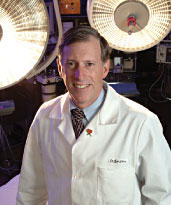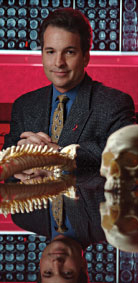 
Michael Borkon used to direct heart transplants at Saint Luke’s Hospital. Today he speaks like a man who has seen his share of cardiac patients:
“It is imperative that everyone—but particularly physicians—have outside interests. You can’t just go to the office all day, then go home to bed.”
For Borkon, the Program Director of the Cardiovascular Product Line at the Mid-America Heart Institute, those interests fall primarily into family and charity. Borkon and his wife have two children and their vacations mountain-climbing and traveling have been geared to help keep the family physically fit, while clearing the mind of daily routines.
“Charity is also important. You can’t just be content with giving a dollar amount; you have to give your time and your abilities,” he says. This year Borkon and his wife are chairing the Heart Ball in Kansas City to raise money and awareness. He also enjoys giving his time to his residents, “which sounds like work,” he admits, “but I believe it’s a way of preparing the next generation to care for the community.” Borkon and his colleagues have the only cardiothoracic residency program in Kansas City.
For years Borkon was an academic, fortunate enough to study medicine at Johns Hopkins University, then do a research fellowship for two years at the National Institute of Health. Borkon returned to Johns Hopkins to teach for four years, and since coming to Kansas City he has been a professor at UMKC’s School of Medicine. But Borkon is quick to point out “patients always come first!” He says that even during the years he primarily focused on research and teaching, he always remembered that the ultimate goal was to equip doctors to care for patients.
“Everything we read about in journals is always about better diagnostic techniques for patients or better treatments for patients. What cardiologists can do today with catheters is just short of miraculous,” Borkon marvels.
Beyond improved technology, Borkon says he believes what distinguishes this era of medicine from all others is the dynamic political landscape. “We live in interesting times,” he says, pointing to another outside interest of his: business. “So many hospital mergers and acquisitions—it’s fascinating to watch unfold.”
|
 
“I was intrigued by this amazing frontier,” says Paul Camarata, remembering the neuroanatomy course he took in his first year of medical school. “Of course, all medical fields are expanding, but it seemed to me that the brain was this major organ system we know the least about. I figured if somebody wants to jump into a wide field of study where everybody is collaborating to figure out what’s going on, neurology is it.”
Camarata says he grew up “in the sticks” (Hays, Kan.) before studying at Stanford and later at the KU School of Medicine. During one summer in medical school, Camarata worked at The Mayo Clinic doing neurological research. Once he had the chance to sit in on several neurological surgeries, he was hooked. Camarata did his residency in Minneapolis, then stayed there for a fellowship in the neurological sub-specialty of cerebrovascular and skull base surgery. After his fellowship, Camarata stayed on at the University of Minnesota as an assistant professor.
“I thought long and hard about staying in academic medicine,” he says, “but there’s only so much time in a day, and only so many days in a lifetime. In the end, I chose patient care, and I try to balance that with spending time with my family.”
Camarata’s family includes his wife Karen, whom he met as a medical student at KU, two daughters and a son, ages 9 to 14. Given his kids’ ages, Camarata says he frequently finds himself trying to get out of the office early to make it to a baseball or soccer game, even if it means heading back in for a few hours of late work. Also important to Camarata are his colleagues at The Kansas City Neurosurgery Group. He believes that in a field where so much is still unknown, teamwork and collaboration are vital keys to unlocking the brain’s mysteries.
“People are winning Nobel Prizes for studying the brain, and there are so many recent surgical advances through minimally invasive procedures that are far less traumatic to the brain. The work we get to be a part of is helping to change medicine everywhere.”
|
|
A biographer for Joe Cates might be tempted to title his book “Small Town Boy Hits Big Time” or possibly “Academe Leaves Classroom for Examining Room.” Dr. Cates grew up on a farm in southern Missouri. In fact, Cates admits his view of the world was small when he applied only to one medical school, assuming he would get in without trouble. His goal was academic medicine, specializing in a field where he could take a prominent role as an educator for future doctors.
His small worldview was right on target, though, because Cates got into the UMKC School of Medicine on his first try, and he quickly grew to love the field of surgery. By the time Cates finished his coursework, he had decided to pursue certification in both general and vascular surgery. His desire for academic medicine led Cates to a 7-year residency at UCLA, two years of which were spent doing what Cates calls “very science-oriented research.”
At the end of his UCLA residency, Cates admits, “I kind of missed taking care of patients.” He still teaches occasionally—for example, Cates has helped many doctors learn how to use stint graphs, and he still enjoys his other clinical teaching opportunities—but today Cates prides himself most on his ability to interact with the people he helps.Cates gets animated discussing the technology he sees impacting his field. Among the advancements is radio frequency oblation of tumors in the liver, a procedure Cates picked up while he was at UCLA and brought with him when he came to the Kansas City area.
When he’s not operating, he likes to spend his free time with his wife—a nurse in Overland Park—and his three daughters, ages 3, 7 and 10. So the biographer for Cates might be tempted to focus on the apparent changes in Cates’ life; but at his core, Cates has always been the guy from a farm in the Midwest with traditional values. Cates even claims he’s still something of a farmer at heart. He bought a farm near Stockton Lake in Missouri, and just last month, he spent a weekend digging holes and putting up fence posts on his land.
|
|